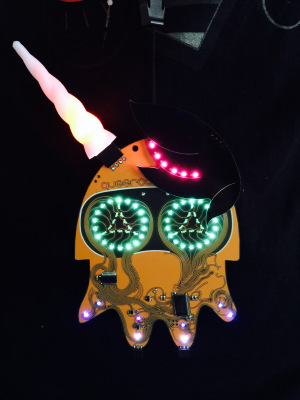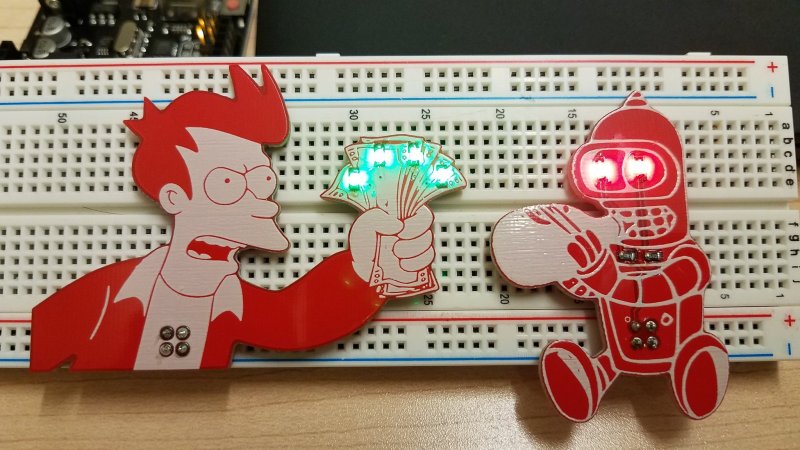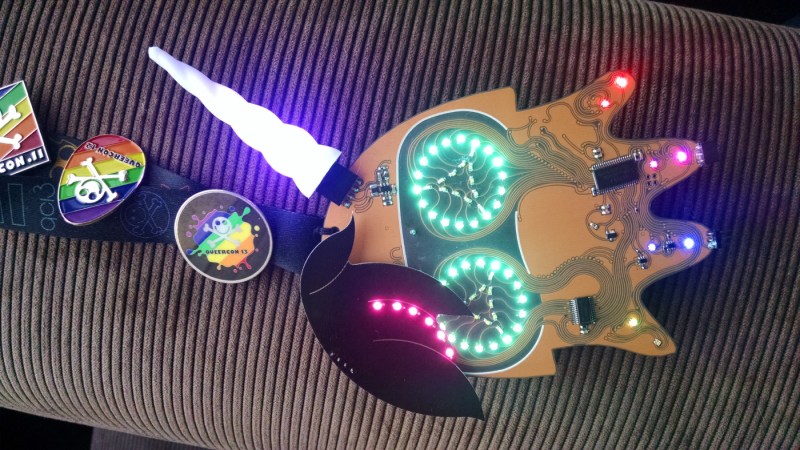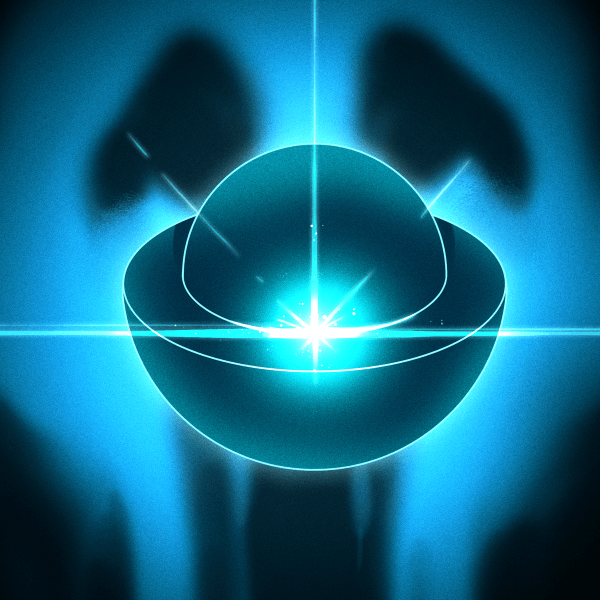Over the last few years, the art and artistry of printed circuit boards has moved from business cards to the most desirable of all disposable electronics. I speak, of course, of badgelife. This is the community built on creating and distributing independent electronic conference badges at the various tech and security conferences around the globe.
Until now, badgelife has been a loose confederation of badgemakers and distributors outdoing themselves each year with ever more impressive boards, techniques, and always more blinky bling. The field is advancing so fast there is no comparison to what was being done in years past; where a simple PCB and blinking LED would have sufficed a decade ago, now we have customized microcontrollers direct from the factory, fancy new chips, and the greatest art you’ve ever seen.
Now we have reached a threshold. The badgelife community has gotten so big, the badges are getting their own badges. This is the year of the badge add-on. We’re all building tiny trinkets for our badges, and this time, they’ll all work together. We’re exactly one year away from a sweet Voltron robot made of badges.
The Pre-History of Badge Add-Ons
Even though this is the year add-ons for conference badges will sweep the floors of casinos, it is not by any means the beginnings of the age of badges for badges.
 The genesis of a standardized spec for add-ons began with the 2016 Queercon badge, distributed at DEF CON 24. This badge, either a squid or a cuttlefish, featured two four-pin headers for ‘hats’. The reason for the hats was simple — one of the main features of the 2016 Queercon badge was the use of clear soldermask, giving the badge a lovely unoxidized copper finish. However, there had to be some differentiation between ‘Uber’ badges for the Queercon organizers and the normal ‘human’ badges for everyone else. Traditionally, this is done with different colors of soldermask. Without that option, Queercon turned to literal light-up hats. The Uber hat was a light-up top hat, the ‘handler’ hat was a red police hat loaded up with a 555, and the normal ‘human’ hat was a beanie with a propeller on top.
The genesis of a standardized spec for add-ons began with the 2016 Queercon badge, distributed at DEF CON 24. This badge, either a squid or a cuttlefish, featured two four-pin headers for ‘hats’. The reason for the hats was simple — one of the main features of the 2016 Queercon badge was the use of clear soldermask, giving the badge a lovely unoxidized copper finish. However, there had to be some differentiation between ‘Uber’ badges for the Queercon organizers and the normal ‘human’ badges for everyone else. Traditionally, this is done with different colors of soldermask. Without that option, Queercon turned to literal light-up hats. The Uber hat was a light-up top hat, the ‘handler’ hat was a red police hat loaded up with a 555, and the normal ‘human’ hat was a beanie with a propeller on top.
The spec for the Queercon hats was leaked a few weeks before DEF CON, and that meant a few people were able to build their own accessories. A light-up unicorn horn was probably the most desirable, and there were even a few emo haircut PCBs that made it onto the Queercon badge:
The add-ons for the 2016 Queercon badge were a smash, and showcased the creativity of the community with independent add-ons supported by the official badge. The idea for add-on badges was picked up by other groups, and the 2017 Saintcon badge was loaded with expansion headers for independent add-ons.

The 2017 Saintcon badge contained four spaces for add-ons arranged as two 8-pin headers on a footprint 0.8″ square. Everything to create a functional and interesting add-on was there: the add-on badges had connections for SPI, I2C, as well as 5 Volts and 3.3 Volts.
The results were spectacular: there were more than a handful of unofficial mini-badges that were soldered onto the Saintcon badge, including a very impressive 8×8 LED matrix from [compukidmike]. For the rest of 2017, add-ons were shoehorned into other badges. Last year’s Bender Badge from AND!XOR had a header for an add-on, and there was a fantastic Brain Slug add-on for members of that crew.
By early 2018, it was obvious add-ons were going to be a thing. The 2016 Queercon add-ons were brilliant in their simplicity, and proved adding a header for an add-on isn’t really that hard, and shouldn’t cost anything. Every microcontroller already has I2C, and if you’re designing a badge, you’re going to have a power rail in there somewhere.
The Beginning of a Standard for Add-Ons

At the beginning of this year, it was clear there had to be a standard for badge add-ons. In February, the badgelife community was busy with the initial layout of their badges, and everyone needed some sort of standard pinout for power, ground, and some connection to a microcontroller.
This led to the creation of the Shitty Add-On Standard. It is, simply, the easiest way to add mini badges to other badges: a 2×2 header with 0.1″ spacing. There is no current limiting, there is no polarity protection. If you plug an add-on in wrong, it will kill the main badge. In fact, that’s the entire point of some add-ons. There is very little mechanical stability for these add-ons, and if you’re using surface mount pin headers, they will rip off.
In short, this spec for add-ons was designed in ten minutes by a complete moron in Microsoft Paint.
However, there is one great strength to the Shitty Add-On spec: it’s dead simple to implement. Nearly every badge being produced for this year’s badgelife extravaganza will have a 3.3 Volt rail. Every microcontroller has an I2C bus somewhere. 0.1″ pin headers are cheap, too. There are problems with it, but the Shitty Add-On spec is the simplest way to support multiple add-on badges.
This Year’s Crop of ‘Shitty Add-Ons’
We’re several weeks out from DEF CON, the main badgelife event, and already the art and artistry coming from badge creators is incredible. There will be dozens of different shitty add-ons, each demonstrating the remarkable craftsmanship of the community:
These are only a handful of the add-ons the badgelife community is making.
This is a banner year for electronic badges. We don’t even know what the official DEF CON badge will be, but the independent badgelife community is managing to do something spectacular this year. If you count add-ons as individual badges, it’s entirely possible there will be more independent badges at this year’s DEF CON than there are attendees. Let that sink in for a moment. DEF CON can’t manage to create enough electronic badges for everyone, and here we have a community of badge builders that have managed to not only build enough badges for everybody, but also to create a platform that everyone can experiment with.
What This Means For You
Badgelife is a hardware demoscene. Instead of typing assembly into a Commodore or Amiga, the badgelife community is rendering electronics in fiberglass and soldermask. It’s an open season for design and engineering, and it’s all happening this summer at various tech and security cons around the world.
The Shitty Add-On standard is the easiest way to get started in Badgelife. Nearly every major badge being distributed this year will come with the proper header, the power supply is taken care for you, and all you have to do is come up with a great design and figure out a way to blink some LEDs.
This is the year the badges get badges, and it’s never been a better time to get started designing your own PCB. It’s the demoscene for hardware, and now it’s open to everybody.
























We pause while someone looks up and posts the XKCD cartoon about Standards…
Would you settle for turtles?
https://imgs.xkcd.com/comics/pixels.png
But, but…
“hat” is already used by the RasPi community!
Function Overload
Badgelife, circa 2002, where the micro was the add on to the display.
http://www.wolftronix.com/badge/images/conbadge00.jpg
Nerds/hackers sure love them some pop culture kitsch.
Only thing more cultured is rich people and yogurt eaters.
How do we get the art and custom shapes into KiCAD? I wanna see an article on that.
Actually, it looks like the entire badgelife community has standardized on Fritzing this year. All the cool badges are using Fritzing.
I’ll do one in Altium Designer then. Just to piss everyone off.
Benchoff already did an article on that. https://hackaday.io/project/18508-mr-robot-badge/log/53901-this-is-how-you-do-art-in-kicad
Tutorial I did with hackster
https://youtu.be/-QPkSICzRDk
https://youtu.be/AfmdjmGnVgo
I2C, so you could potentially stack hats if the addresses don’t conflict, to say put that taco badge-hat into the Mr. Meeseeks badge-hat’s mouth.
Now those Hexabits reported yesterday need to incorporate the S A-O S connector!
Or put an Attiny on so you can reconfigure it as you see fit (this would enable stacking of one of each design). Going to design a badge and add-ons sometime and go to a con.
Are the Bender badges powered by a 6502?
A lot of DEF CON badge creators are listing their badges and SAO on Tindie right now – https://www.tindie.com/browse/electronic-badges/